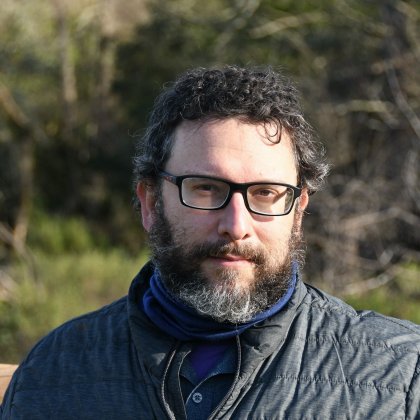Under the Sun: Dan Levitis, biologist

The Sun’s Anna Pier sits down with Dan Levitis, PhD, to learn what he does for Sonoma Ecology Center at Sugarloaf State Park, how he got there, and to delve into his work passions.
What’s been your path to Sugarloaf? When I was six years old, I announced I was going to be a zoologist. I got a Bachelors in biology, and before starting Ph.D.work at UC Berkeley, did a variety of field jobs. I found Florida scrub Jay nests, studied the behavior of birds in the Bronx zoo, banded migrating birds in Canada, tracked CA Condors in Ventura Co. I’ve lived in nine states – California four times – and Papua New Guinea, Canada, Australia, Switzerland, Germany and Denmark.
How did you come to Sonoma? Sonoma itself was happenstance.
After post-doc work in Germany, I taught in Denmark, in Maine, and the University of Wisconsin. I realized that I get sick in cold climates. My wife grew up in northern CA, so we moved here in 2018. With my cousin, in a moving van going 70 MPH on the “Loneliest Road in the U.S.” –Hwy 50 in Nevada, we flipped. When I was recovering from surgery for the spinal injury, I volunteered for the Sonoma Ecology Center. Then they hired me as Volunteer Coordinator.
What’s it like to work at Sugarloaf? It is a true gift. Spending time in nature frequently is essential to me, and getting paid to do so is just lovely. Getting to help others benefit from time in nature is even better.
I’m writing proposals now for a grant to fund a new program, Community Science in the Springs. It would focus on Sonoma Creek, and hopefully involve people of all ages from the disadvantaged community.
I love the Springs community. My three children have all been in the dual immersion program at Flowery School. Sadly, we got priced out of getting a home there. After a year of looking, we had to settle for buying in Santa Rosa.
What does the Community Science Coordinator do? Many things. I’ve been leading naturalists and community volunteers to document all the species at the Sonoma Developmental Center and Sugarloaf. We’ve photographed, identified and uploaded to iNaturalist over 1,200 plants, animals, and fungi at SDC, and 1827 at Sugarloaf.
Teaching. I’m a professor and I had missed it. I’ve had adult class series at Sugarloaf in field zoology, climate stewardship, and, with Tony Passantino, a course to certify California Naturalists. Upcoming is a two-day course funded by the Sonoma Valley Ed Foundation on Fire Resiliency. We’ll have 14 teachers from all grade levels, who will teach on these topics in their classrooms. And I have a passion for science and nature writing, so I have a course coming up on Nature Writing for Conservation.
What do you do as Volunteer Coordinator at Sugarloaf? We have 211 active volunteers, and they do everything from staffing the Visitors Center to preparing trails to leading hikes. They are why the park is so well taken care of, even the bathrooms are clean. They set up and monitor the 40 plus critter cams we have all over the park. I’ve designed and carried out their teaching and training.
What wildlife have you captured on the critter cams?
We have tens of thousands of videos. The cams have trapped multiple bears – including a mama with cubs – and mountain lions, lots of deer, turkeys. And we’ve found otters, minks, and a badger in Mayacamas Creek. There’s a fascinating video of a Great Horned Owl scarfing down a California Giant Salamander nearly a foot long. The owl didn’t know it was a protected species, so we can’t blame it.
What do you do with the data? We share it with organizations such as the North Bay Bear Collaborative and North Bay Lion Conservation Project. We post lots of the videos on social media.
What are you studying now? Science and how access to nature affects longevity. I am really interested in expanding access to nature for the disadvantaged. We’ve handed out lots of day passes to Sugarloaf at food banks and other places. I know that doesn’t eliminate all the obstacles, but maybe it helps. Our Senderos program at Sugarloaf offers free hiking and camping experiences in all Spanish. When I was recovering from the spinal injury in 2018, I experienced firsthand how experiences in nature help with healing.
In a Letter to the Sun Editor you identify the City of Sonoma as a “NORC” – a Naturally Occurring Retirement Community. Have any City officials been in touch with you about your suggestions? So far, no one.
As a biologist, how did you get into quantitative demographic research? My dissertation at UC Berkeley was on the Evolution of Post-reproductive Survival. I did post-doc work at the Max Planck Institute in Germany to find a meaningful measure of post-reproductive survival across species. People live on average 40% of their life in post-reproductive years. The average for all other species is 2 – 5%.
Tell me about your family.
My wife Iris is a grant writer for an environmental engineering firm that cleans up polluted sites in socio-economically disadvantaged communities. We have three young children, born in Germany, Denmark, and Wisconsin. And we have a Ukrainian family living with us, a mother and young son we brought here on the the Biden administration’s refugee program. Friends helped us raise the money for the airfare.
Photo by Gardner Smith
Note: The answers attributed to the interviewee are in part paraphrases and in part quotes.



